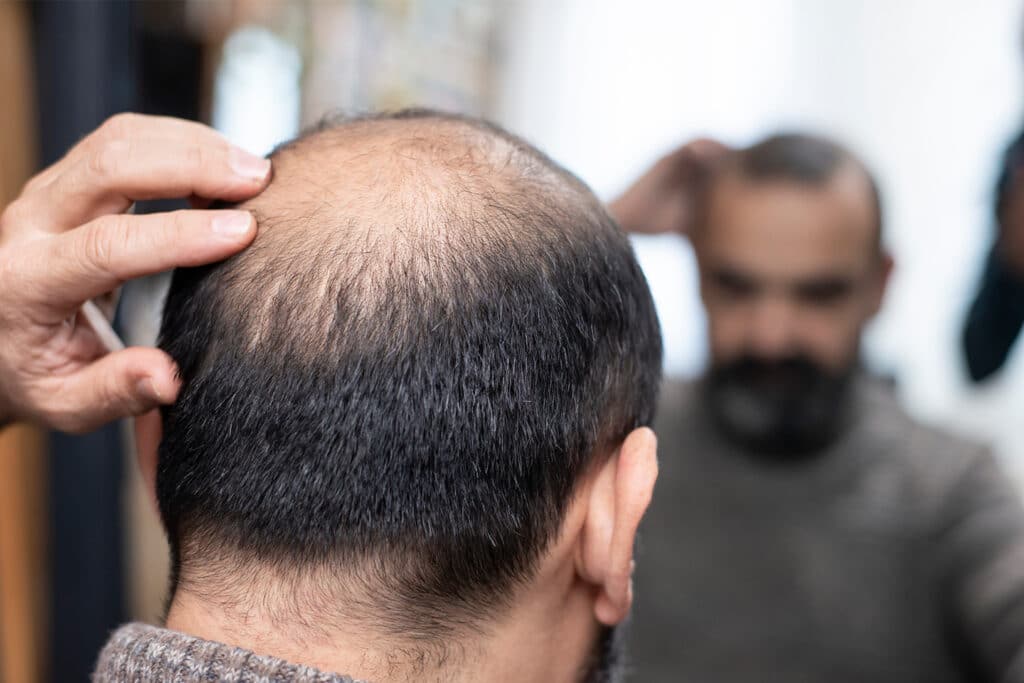Each hair follicle has a life-cycle of its own, and at any given time, about 90 percent of the hair on your head is in a growing mode. The other 10 percent is in a resting mode. After about four months, the resting hair falls out and new growing hair takes its place. As part of this natural cycle, it is normal to shed hair each day; however, some individuals experience excessive or above-normal loss.

Both men and women can experience hair loss due to a number of different factors including disease or reactions to medications. The most common type of hair loss, however, is androgenetic alopecia, commonly called male or female pattern baldness (MPB and FPB).
According to the American Hair Loss Association, male pattern baldness (MPB) accounts for more than 95 percent of hair loss in men. By the age of 35, two-thirds of American men will experience some degree of appreciable hair loss, and by the age of 50, roughly 85 percent of men will experience significantly thinning hair. Approximately 25 percent of men who suffer with MPB begin the painful process before they reach the age of 21.
MPB is a gradual thinning; it is not abrupt and cannot be reversed in later stages. “Losing up to 100 hairs per day is considered normal hair loss,” says Dr. F. Hall Reynolds, dermatologist at the Chattanooga Skin and Cancer Center. “About 50 percent of a person’s total hair must be shed for thinning to be noticeable.”
Causes of MPB
While there are many possible reasons people lose hair, most hair loss in men can be blamed on heredity. According to Victor Czerkasij, certified nurse practitioner at the Skin Cancer and Cosmetic Dermatology Center in Cleveland, Tenn., “Heredity plays a powerful role, and the traits can be inherited from either the mother or father’s side of the family.”
The hormone inherited, and the main cause of MPB, is dihydrotestosterone (DHT), a derivative or by-product of testosterone. Testosterone converts to DHT with the aid of the enzyme 5-alpha-reductase.
DHT is devastating to hair follicles, damaging them and causing them to shrink. Damaged hair follicles fall out and are never replaced by new ones. Dr. Reynolds says, “Hair cells all over the body are exposed to normal hormones and chemicals throughout their lifespan,” but during middle age, even earlier in some cases, the cells begin reacting in a peculiar fashion to DHT. Instead of the usual 90 percent growing and 10 percent resting and shedding cycle, hair cells gradually shift to less growing and more shedding. Hair follicles get smaller. “Hairs gets thinner, shorter, and eventually just don’t grow,” says Dr. Reynolds.
An overactive or underactive thyroid and some medications can also be culprits in hair loss, which stops when the medicine is discontinued. Hair loss can also be an early sign of diabetes.
Non-Surgical Treatment
Research into androgenetic alopecia is quite limited, even though the number of researchers studying the area is growing. Czerkasij says, “Men still need to know the options and limitations of treatment.”
Although there is no magical potion that can restore hair to its youthful glory, some remedies are effective. Two medicinal treatments have been approved by the Food and Drug Administration (FDA) for the treatment of MPB, but the effectiveness of a medication will depend on the cause and extent of the hair loss.
- Minoxidil (Rogaine): This popular over-the-counter drug is rubbed directly into the scalp and works best on areas where there is still some hair. Its use may result in hair regrowth, a slower rate of hair loss or both. The medication must be used daily; otherwise, the regrown hair will be lost within about three months of discontinued use.
- Finasteride (Propecia): This is an oral prescription designed for men only. Women are cautioned to not even handle Propecia, as it can cause birth defects. Its use slows hair loss and stimulates regrowth, primarily at the top and middle-front of the head. A Consumer Reports survey of 8,000 men and women found that 27 percent of the men who used Propecia reported that it was “very effective.”
Both minoxidil and finasteride are beneficial but require continued use. Other non-surgical treatments for hair loss include full wigs, cap wigs, weaves and integration hairpieces.
Surgical Treatment
Hair transplantation is a surgical procedure that can be done in a doctor’s office under local anesthesia. In a transplant, the doctor moves grafts of healthy hair from the back or side of the scalp to the balding or thinning areas. Depending on the extent of the procedure, the transplant may take between four and eight hours. New hair should begin to grow within a few months.
As with any medical procedure, hair transplants involve risks, which include bleeding and infection; however, complications have been found to be minimal. Among the men in the Consumer Reports survey, 2 percent had undergone transplants, and of those, 49 percent were either “very” or “completely satisfied” with the results. Dr. Reynolds considers transplantation the “most efficient method” of restoring hair in MPB.
Hair transplants can be costly, depending on the amount of hair to be transplanted. One source estimates a range of between $4,000 and $15,000. Insurance rarely covers this procedure.
The Self-Esteem Factor
“Hair loss absolutely affects how men feel about themselves,” says Czerkasij. Men approach the issue of baldness differently. Some men are deeply affected emotionally by MPB, while others, including well-known actors and athletes such as Bruce Willis, Sean Connery, and Charles Barkley have embraced their appearances. Czerkasij says, “Compassion, support and a goal toward acceptance of the condition help make the transition less difficult.”




